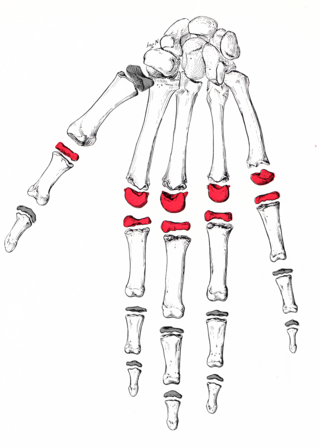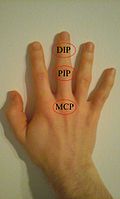Top Qs
Timeline
Chat
Perspective
Metacarpophalangeal joint
Bodily joint at the base of each finger From Wikipedia, the free encyclopedia
Remove ads
The metacarpophalangeal joints (MCP) are situated between the metacarpal bones and the proximal phalanges of the fingers.[1] These joints are of the condyloid kind, formed by the reception of the rounded heads of the metacarpal bones into shallow cavities on the proximal ends of the proximal phalanges.[1] Being condyloid, they allow the movements of flexion, extension, abduction, adduction and circumduction (see anatomical terms of motion) at the joint.[1]
This article's lead section may be too technical for most readers to understand. (December 2024) |
Remove ads
Structure
Ligaments
Each joint has:
Dorsal surfaces
The dorsal surfaces of these joints are covered by the expansions of the Extensor tendons, together with some loose areolar tissue which connects the deep surfaces of the tendons to the bones.
Remove ads
Function
The movements which occur in these joints are flexion, extension, adduction, abduction, and circumduction; the movements of abduction and adduction are very limited, and cannot be performed while the fingers form a fist.[2]
The muscles of flexion and extension are as follows:
Remove ads
Clinical significance
Arthritis of the MCP is a distinguishing feature of rheumatoid arthritis, as opposed to the distal interphalangeal joint in osteoarthritis.
Other animals
In many quadrupeds, particularly horses and other larger animals, the metacarpophalangeal joint is referred to as the "fetlock". This term is translated literally as "foot-lock". In fact, although the term fetlock does not specifically apply to other species' metacarpophalangeal joints (for instance, humans), the "second" or "mid-finger" knuckle of the human hand does anatomically correspond to the fetlock on larger quadrupeds. For lack of a better term, the shortened name may seem more practical.
See also
References
External links
Wikiwand - on
Seamless Wikipedia browsing. On steroids.
Remove ads




